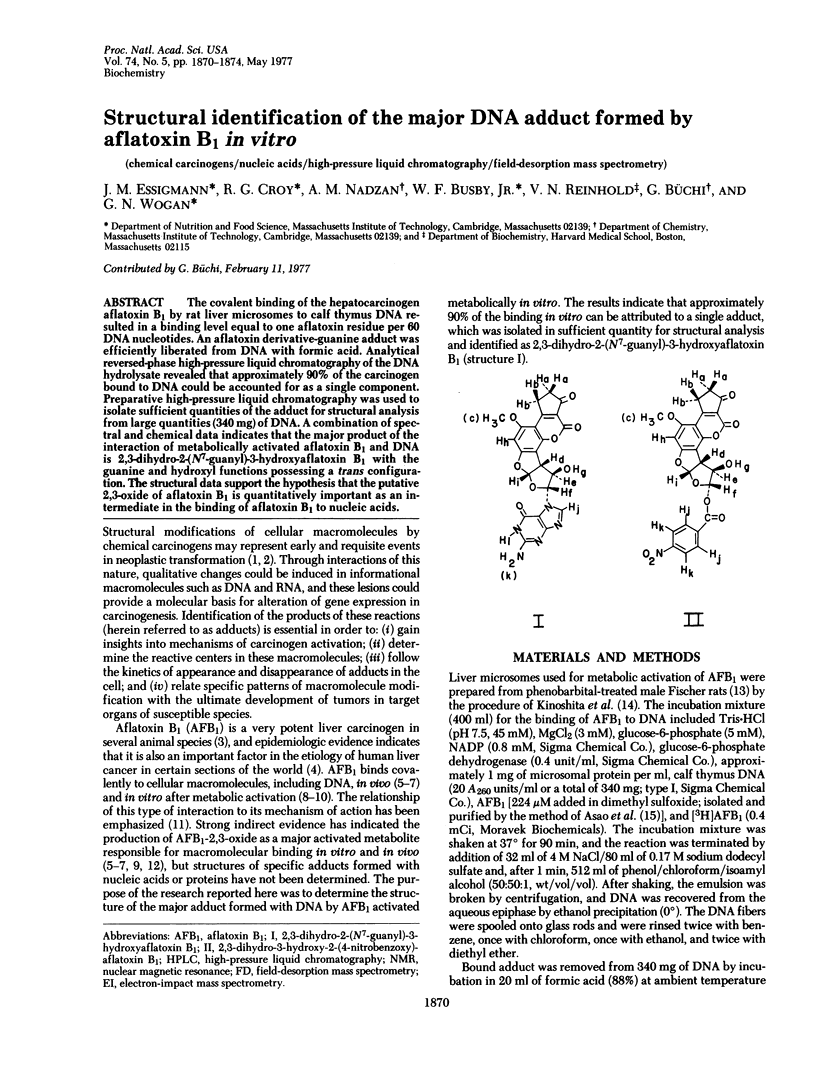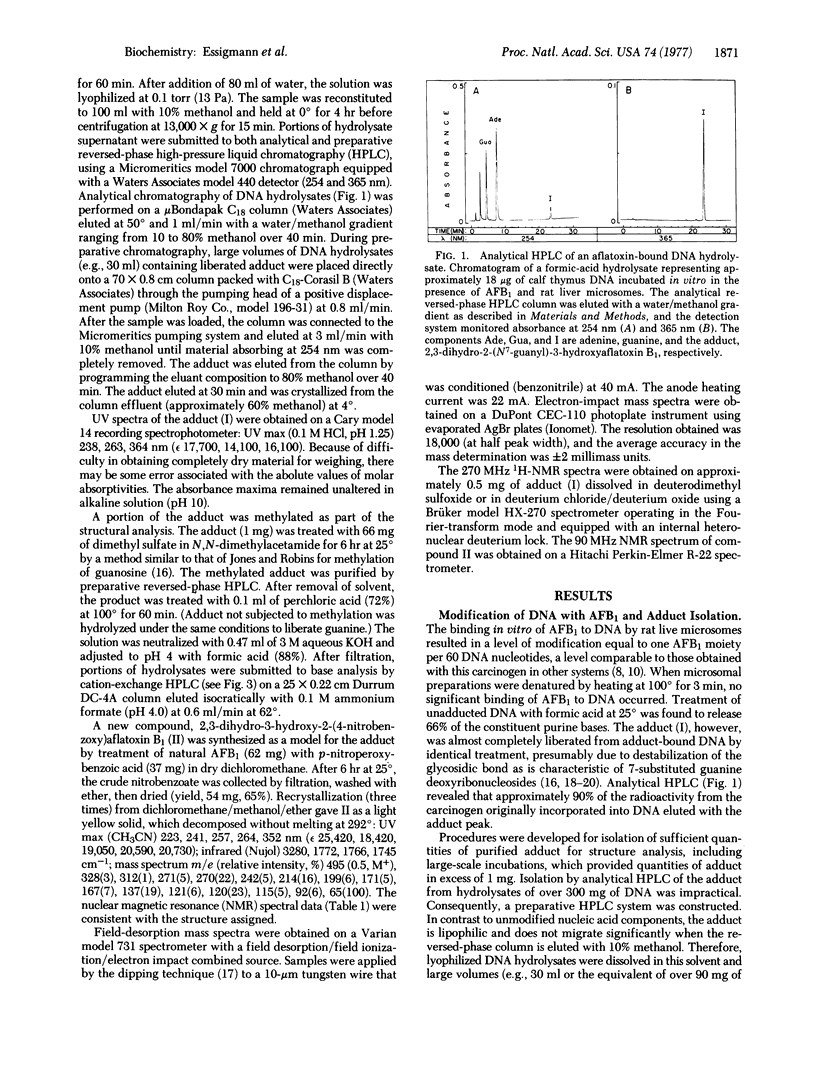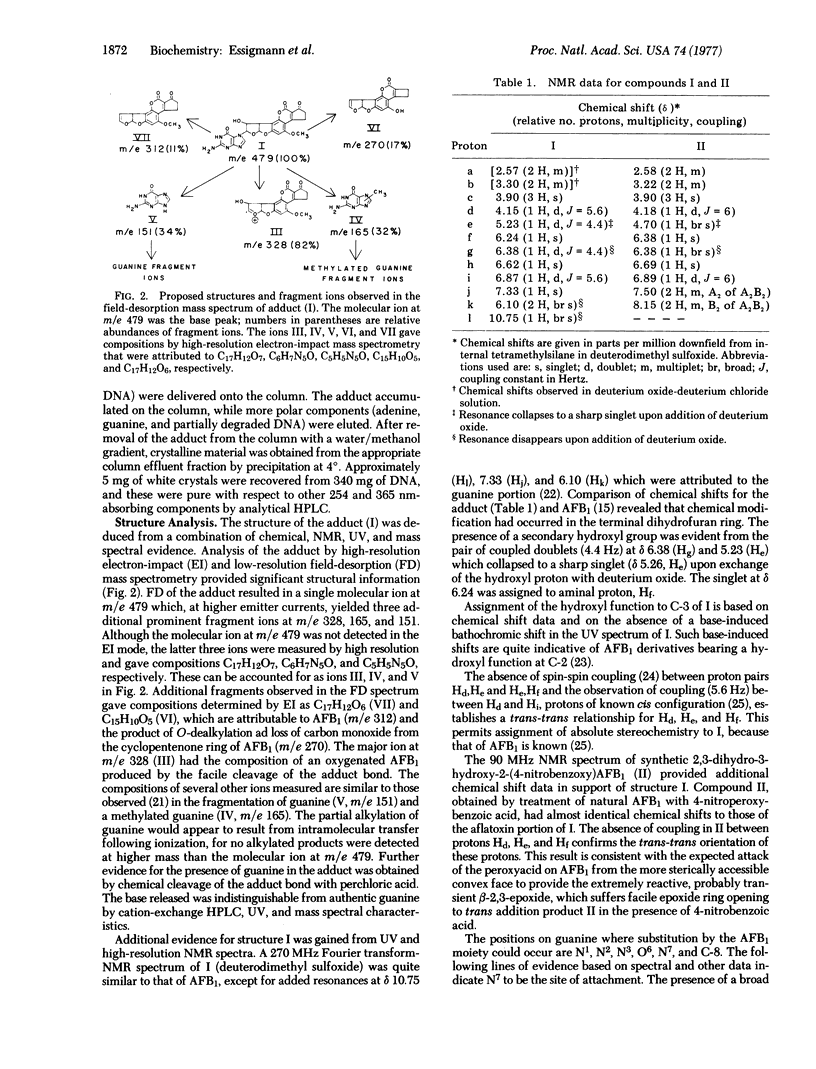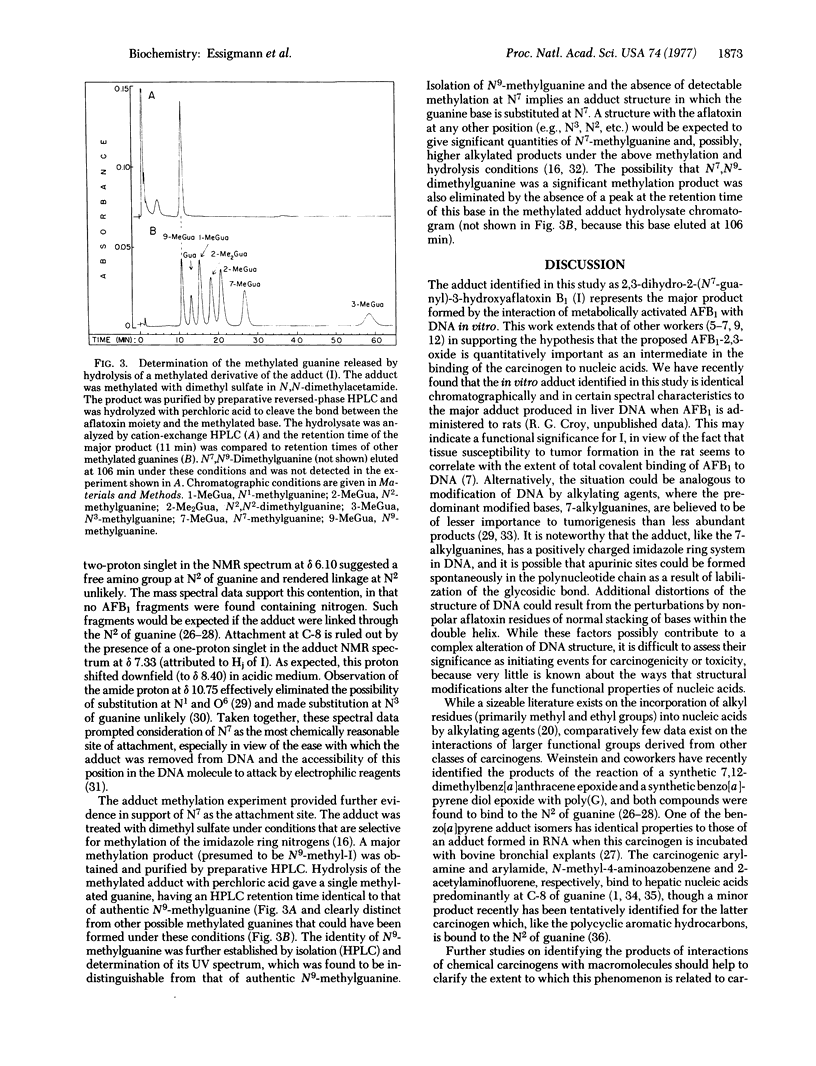Abstract
The covalent binding of the hepatocarcinogen aflatoxin B1 by rat liver microsomes to calf thymus DNA resulted in a binding level equal to one aflatoxin residue per 60 DNA nucleotides. An aflatoxin derivative-guanine adduct was efficiently liberated from DNA with formic acid. Analytical reversed-phase high-pressure liquid chromatography of the DNA hydrolysate revealed that approximately 90% of the carcinogen bound to DNA could be accounted for as a single component. Preparative high-pressure liquid chromatography was used to isolate sufficient quantities of the adduct for structural analysis from large quantities (340 mg) of DNA. A combination of spectral and chemical data indicates that the major product of the interaction of metabolically activated aflatoxin B1 and DNA is 2,3-dihydro-2-(N7-guanyl)-3-hydroxyaflatoxin B1 with the guanine and hydroxyl functions possessing a trans configuration. The structural data support the hypothesis that the putative 2,3-oxide of aflatoxin B1 is quantitatively important as an intermediate in the binding of aflatoxin B1 to nucleic acids.
Full text
PDF




Selected References
These references are in PubMed. This may not be the complete list of references from this article.
- ASAO T., BUECHI G., ABDEL-KADER M. M., CHANG S. B., WICK E. L., WOGAN G. N. THE STRUCTURES OF AFLATOXINS B AND G. J Am Chem Soc. 1965 Feb 20;87:882–886. doi: 10.1021/ja01082a031. [DOI] [PubMed] [Google Scholar]
- Brechbühler S., Büchi G., Milne G. The absolute configuration of the aflatoxins. J Org Chem. 1967 Aug;32(8):2641–2642. doi: 10.1021/jo01283a068. [DOI] [PubMed] [Google Scholar]
- Büchi G., Foulkes D. M., Kurono M., Mitchell G. F., Schneider R. S. The total synthesis of racemic aflatoxin B1. J Am Chem Soc. 1967 Dec 6;89(25):6745–6753. doi: 10.1021/ja01001a062. [DOI] [PubMed] [Google Scholar]
- Garner R. C. Microsome-dependent binding of aflatoxin B1 to DNA, RNA, polyribonucleotides and protein in vitro. Chem Biol Interact. 1973 Feb;6(2):125–129. doi: 10.1016/0009-2797(73)90079-3. [DOI] [PubMed] [Google Scholar]
- Garner R. C., Wright C. M. Binding of [-14C]aflatoxin B1 to cellular macromolecules in the rat and hamster. Chem Biol Interact. 1975 Aug;11(2):121–131. doi: 10.1016/0009-2797(75)90019-8. [DOI] [PubMed] [Google Scholar]
- Goth R., Rajewsky M. F. Molecular and cellular mechanisms associated with pulse-carcinogenesis in the rat nerbous system by ethyinitrosourea: ethylation of nucleic acids and elimination rates of ethylated bases from the DNA of different tissues. Z Krebsforsch Klin Onkol Cancer Res Clin Oncol. 1974;82(1):37–64. doi: 10.1007/BF00304382. [DOI] [PubMed] [Google Scholar]
- Gurtoo H. L., Dave C. V. In vitro metabolic conversion of aflatoxins and benzo(alpha)pyrene to nucleic acid-binding metabolites. Cancer Res. 1975 Feb;35(2):382–389. [PubMed] [Google Scholar]
- Jeffrey A. M., Blobstein S. H., Weinstein I. B., Beland F. A., Harvey R. G., Kasai H., Nakanishi K. Structure of 7,12-dimethylbenz(a)anthracene-guanosine adducts. Proc Natl Acad Sci U S A. 1976 Jul;73(7):2311–2315. doi: 10.1073/pnas.73.7.2311. [DOI] [PMC free article] [PubMed] [Google Scholar]
- Jeffrey A. M., Jennette K. W., Blobstein S. H., Weinstein I. B., Beland F. A., Harvey R. G., Kasal H., Miura I., Nakanishi K. Letter: Benzo[a]pyrene-nucleic acid derivative found in vivo: structure of a benzo[a]pyrenetetrahydrodiol epoxide-guanosine adduct. J Am Chem Soc. 1976 Sep 1;98(18):5714–5715. doi: 10.1021/ja00434a060. [DOI] [PubMed] [Google Scholar]
- Kinoshita N., Shears B., Gelboin H. V. K-region and non-K-region metabolism of benzo(a)pyrene by rat liver microsomes. Cancer Res. 1973 Aug;33(8):1937–1944. [PubMed] [Google Scholar]
- Lawley P. D., Jarman M. Alkylation by propylene oxide of deoxyribonucleic acid, adenine, guanosine and deoxyguanylic acid. Biochem J. 1972 Feb;126(4):893–900. doi: 10.1042/bj1260893. [DOI] [PMC free article] [PubMed] [Google Scholar]
- Lin J. K., Miller J. A., Miller E. C. Structures of hepatic nucleic acid-bound dyes in rats given the carcinogen N-methyl-4-aminoazobenzene. Cancer Res. 1975 Mar;35(3):844–850. [PubMed] [Google Scholar]
- Lin J. K., Schmall B., Sharpe I. D., Miura I., Miller J. A., Miller E. C. N-substitution of carbon 8 in guanosine and deoxyguanosine by the carcinogen N-benzoyloxy-N-methyl-4-aminoazobenzene in vitro. Cancer Res. 1975 Mar;35(3):832–843. [PubMed] [Google Scholar]
- Loveless A. Possible relevance of O-6 alkylation of deoxyguanosine to the mutagenicity and carcinogenicity of nitrosamines and nitrosamides. Nature. 1969 Jul 12;223(5202):206–207. doi: 10.1038/223206a0. [DOI] [PubMed] [Google Scholar]
- Marshall W. J., McLean A. E. The effect of oral phenobarbitone on hepatic microsomal cytochrome P-450 and demethylation activity in rats fed normal and low protein diets. Biochem Pharmacol. 1969 Jan;18(1):153–157. doi: 10.1016/0006-2952(69)90020-3. [DOI] [PubMed] [Google Scholar]
- Miller J. A. Carcinogenesis by chemicals: an overview--G. H. A. Clowes memorial lecture. Cancer Res. 1970 Mar;30(3):559–576. [PubMed] [Google Scholar]
- Rice J. M., Dudek G. O. Mass spectra of nucleic acid derivatives. II. Guanine, adenine, and related compounds. J Am Chem Soc. 1967 May 24;89(11):2719–2725. doi: 10.1021/ja00987a039. [DOI] [PubMed] [Google Scholar]
- Swenson D. H., Lin J. K., Miller E. C., Miller J. A. Aflatoxin B1-2,3-oxide as a probable intermediate in the covalent binding of aflatoxins B1 and B2 to rat liver DNA and ribosomal RNA in vivo. Cancer Res. 1977 Jan;37(1):172–181. [PubMed] [Google Scholar]
- Swenson D. H., Miller E. C., Miller J. A. Aflatoxin B1-2,3-oxide: evidence for its formation in rat liver in vivo and by human liver microsomes in vitro. Biochem Biophys Res Commun. 1974 Oct 8;60(3):1036–1043. doi: 10.1016/0006-291x(74)90417-3. [DOI] [PubMed] [Google Scholar]
- Swenson D. H., Miller J. A., Miller E. C. 2,3-Dihydro-2,3-dihydroxy-aflatoxin B1: an acid hydrolysis product of an RNA-aflatoxin B1 adduct formed by hamster and rat liver microsomes in vitro. Biochem Biophys Res Commun. 1973 Aug 21;53(4):1260–1267. doi: 10.1016/0006-291x(73)90601-3. [DOI] [PubMed] [Google Scholar]
- Swenson D. H., Miller J. A., Miller E. C. The reactivity and carcinogenicity of aflatoxin B1-2,3-dichloride, a model for the putative 2,3-oxide metabolite of aflatoxin B1. Cancer Res. 1975 Dec;35(12):3811–3823. [PubMed] [Google Scholar]
- Weinstein I. B., Jeffrey A. M., Jennette K. W., Blobstein S. H., Harvey R. G., Harris C., Autrup H., Kasai H., Nakanishi K. Benzo(a)pyrene diol epoxides as intermediates in nucleic acid binding in vitro and in vivo. Science. 1976 Aug 13;193(4253):592–595. doi: 10.1126/science.959820. [DOI] [PubMed] [Google Scholar]
- Westra J. G., Kriek E., Hittenhausen H. Identification of the persistently bound form of the carcinogen N-acetyl-2-aminofluorene to rat liver DNA in vivo. Chem Biol Interact. 1976 Oct 2;15(2):149–164. doi: 10.1016/0009-2797(76)90160-5. [DOI] [PubMed] [Google Scholar]


